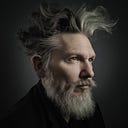Darious, I really appreciate your insights on this. You've raised an important point—art isn't always about expression, and the intent behind creating art can vary widely. AI-generated art can be utilitarian, much like an artist creating work for a specific client, where the focus is on fulfilling a purpose rather than conveying a deeply personal message. For example, AI-generated art is often used in advertising to quickly produce visuals that align with a brand's campaign, or in video game design to create background assets that serve a functional role without requiring individual artistic expression. In this way, AI functions similarly to how a copy machine or a camera does, helping manifest a vision that starts in the creator's mind.
The comparison you make between photography and AI prompts is insightful. As a former professional photojournalist, photo editor, and photography instructor, I agree that both photography and AI require an initial vision, an idea that is then captured or realized through a tool. That initial spark, that human input, is where the ownership comes from—whether it's framing a shot or crafting a prompt. The tools are secondary to the creativity that drives them.
I completely understand why you'd use AI to support your creative process. Efficiency is key, especially when working across different mediums and platforms, such as digital illustrations, 3D modeling software, social media content creation, and animation tools. Using AI as part of your workflow makes perfect sense, especially if it allows you to focus on the aspects of creation that truly matter to you.
Thanks again for adding such a thoughtful dimension to this conversation. It's these diverse perspectives that keep this dialogue enriching for all of us.
Warmest regards!
